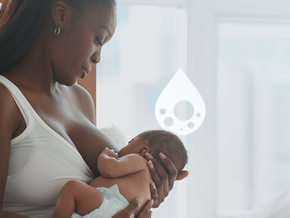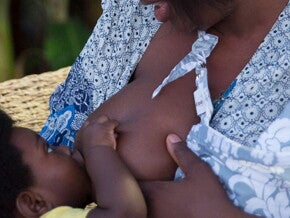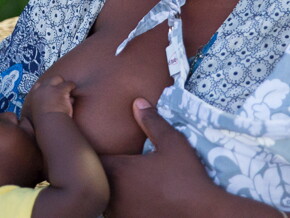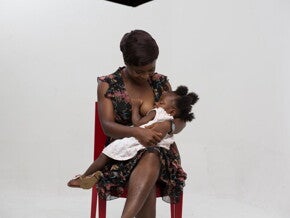
Your Breastfeeding Guide, Tips, and Much More
For starters, learn as much as you can even before baby arrives (it’s an ideal part of you being prepared to breastfeed)—and follow this guide! You’ll be aware of common challenges and feel ready to get this wonderful bonding experience off to a good start for both you and your baby.
First things first
Breastfeeding exclusively for the first six months, and sustaining it for up to two years or longer with appropriate complementary feeding, is important for your baby’s nutrition, immunologic protection, growth, and development. It also benefits you and marks one of your first major connections with your baby.
Before baby: Make breastfeeding plans
Don’t wait for baby, put your plan in place before she’s born by reading, gathering opinions and asking questions about breastfeeding. Here are a few quick things you can do to set you and your newborn up for success:
- Assess your nipples: Consult your doctor, midwife, or lactation counsellors if your nipples are flat or inverted.
- Fill out your own menu: Pack your freezer and fridge with prepared meals and snacks.
- Surround yourself with support: Lean on your partner, family and friends (cooking, chores, you name it).
Too soon? There’s no such thing
The ideal time to begin breastfeeding? As soon as possible, or within 30 to 60 minutes of your baby being born.
It’s never too early for skin-to-skin contact, either. It helps initiate breastfeeding and can make the very first feeding great—which, studies have shown, can contribute to your breastfeeding success down the road.
Breastfeed on demand
No matter what you’ve heard, remember this: Feed your baby whenever she seems hungry. Honest. The more she nurses, the more milk you produce.
Expect to feed every 2-3 hours (yes, through the night, too)—basically, 8-12 times within 24 hours. Keeping baby safely within earshot while you sleep can ensure that, from the start, your baby feeds whenever she likes.
Establish a routine
Relax and make yourself, and your baby, comfortable, with a breastfeeding routine that includes:
- Your favourite armchair or rocking chair.
- A nursing pillow (Support for your baby on your lap).
- A nursing stool (Elevating your feet eases back strain).
- A large glass of water and perhaps a healthy snack.
Don't feel rushed
You’ll want to feel like SuperMum right away, but when it comes to breastfeeding, there’s no use putting any pressure whatsoever on you and your baby. Take your time, remain calm (it’ll help calm baby), remove distractions and do not hesitate to seek breastfeeding support from your health care professional and lactation counsellors etc.
Your breastfeeding checklist: Latch. Release. Repeat.
- Bring your baby to your breast: Rather than your breast to your baby.
- Hold her close to your body: Skin-to-skin, tummy-to-tummy, face-to-breast, mouth-to-nipple.
- Support her neck and shoulders: Don’t push on the back of your baby’s head—she may push back from the breast.
- Make sure her body is straight: Ear, shoulder and hip should be aligned (A twisted neck makes swallowing difficult).
- Support your breast: Hold your fingers underneath, away from the areola (the dark area), with your thumb on top.
- Start with a good latch: Stimulate her lips and rooting reflex by gently caressing her lips with your nipple until her mouth opens as big as a yawn.
- Push your baby across her shoulders: While her mouth is still wide open, ensure the chin and lower jaw make first contact with your breast.
- Confirm your nipple placement: The last step in a good latch, it should be as far back in your baby’s mouth as possible, and angled toward the roof of her mouth.
- Release, re-position and re-latch as you see fit: Whenever, release your baby’s suction by placing a finger in the corner of her mouth (between her lower and upper gums) until the suction is broken. For good hygiene, wash your hands with soap and water prior to breastfeeding.
- Repeat and take care: You’ll feed A LOT, so don’t hesitate to apply some expressed breast milk or nipple cream between feedings (right from the start), even if you’re not experiencing pain or cracking.
Signs of success
When baby feels your nipple with her tongue, the upper lips will close over, covering the nipple and as much of the areola as possible, and seal it. Both lips should be rolled outwards. You should see sucking motions along the jawline (She may start quickly, and as you continue to breastfeed, move on to slower, deeper sucks).
Once baby has latched and the milk comes down, you'll notice pronounced jaw movements and hear small swallowing noises from your baby.
After enough milk has transferred to baby, your breasts will feel softer and less full than before the feed.
Position, position, position
The key to effective breastfeeding?
You got it, good position. Try a variety of the positions below, and choose the one (or more) that feel comfortable for both you and your baby.
Cross-cradle hold
- How? This one will seem very similar to the cross-cradle hold. Sit upright. Place your baby on her side across your lap, facing you. Support her head with the crook of your elbow and her back and bottom with your forearm.
- Why? No special reason, really, except that it’s among the more common breastfeeding positions.
Football hold
- How? Tuck your baby under your arm (like a football player carries the ball), holding her head and neck in your hand, feet extending toward your back. Support your arm with a pillow at your side.
- Why?If you've had a caesarean delivery or have large breasts you may find this position more comfortable. It's also helpful if your baby tends not to take enough of your nipple and areola into his mouth while you’re in other positions. Have twins? This is one way you can breastfeed two babies at once.
Side-laying
- How? Lie on your side with your baby on her side, facing you. Use the hand underneath you to help position your baby's head at your lower breast as you pull her closer to you with the other hand. When baby has attached to your breast, use your lower hand to support her head.
- Why?Another option if you're recovering from a caesarean delivery, this is also called a "snack-and-snooze" position.
Alternate positions
- How?Try holding your baby a variety of ways while you breastfeed, and change it up if you think it will help.
- Why?Changing positions helps the milk ducts to drain and prevents your baby from sucking on the same area of your nipple. Plus, switching things up is helpful if you are experiencing nipple soreness or small, hard lumps in your breast caused by the ducts being plugged with breast milk.
Concerns & Common Challenges
Sore nipples
Again, following a bit of discomfort in the initial days, breastfeeding should be pain-free. The best way you can prevent sore nipples is to help your baby latch properly. Remember that you can coax your baby to release and re-latch if you experience pain during breastfeeding, but if your painful feedings continue you should talk to your health care professional or lactation counsellor.
Nipple care
Here’s how to take care of yourself between feedings so you can give your baby the feeding care she needs:
- Don’t rub your nipples: Using soap or a towel may damage or dry the sensitive skin on the nipple.
- Apply breast milk instead: After a feeding, gently coat your nipples with your own breast milk.
- Let your nipples air dry: Only put your bra back on once your nipples feel completely dry.
- Choose the right bra: Pick a good support bra to prevent your breasts from becoming engorged.
- Avoid underwire bras: These may actually contribute to plug ducts.
- Seek help for cracking/bleeding nipples: Talk to your health care professional about available nipple creams.
Leaking
While it’s completely natural, especially within the first few months after birth, you can help hide that your breasts are leaking by wearing washable or disposable breast pads. Better news? You can probably do away with them around the 20-week mark when the leakage should stop.
Breast fullness
It’s around day three and your breasts feel fuller. This period lasts about 24 hours and it’s also natural because milk production has increased, also known as your milk “coming in.”
Feeding your baby on demand will help your body regulate its milk production and after a few months, once your body adapts to the needs of your baby, you can wave good-bye to breast fullness. Frequent feeding (basically whenever she wants) promotes a more constant supply and is also important to help prevent breast engorgement from occurring or reoccurring.
Since you may continue to experience breast fullness (now and again up until around 16-20 weeks post-partum), here’s how you can manage it:
- Try taking a warm shower, or applying a warm wash cloth prior to breastfeeding, if your baby has trouble latching because of breast fullness.
- Express some milk by hand or use a breast pump, so your breasts are less full before breastfeeding
- Allow your baby to feed as much as they want on your first breast and hand-express your other breast if they do not move to it during that feeding.
- Put a cold compress or ice pack on your breasts after breastfeeding to reduce swelling (10 minutes only).
- Use cleaned, refrigerated cabbage leaves for a few minutes after breastfeeding (It’s how some women have found relief).
- Avoid wearing tight bras or even bras that are too loose—a well-fitted bra will work wonders.
Engorgement
Your milk “coming in”, around the third or fourth day, may also cause your breasts to become engorged. They’ll feel swollen or hard, and uncomfortable, but it’s completely natural and very important that you continue breastfeeding. Plus, you can look to the same tips you would for managing breast fullness and contact your health care professional or lactation counsellor for advice. Quick intervention is the best way to relieve discomfort and to ensure your baby’s getting enough milk.
Plugged ducts
If you notice a lump in your breast that hurts to touch, or even a white spot in the nipple (they sometimes appear)—you’ve found a plugged duct where your milk isn’t being fully drained causing a buildup of milk and inflammation in the surrounding tissue. Before you do anything else, talk to your healthcare professional if you feel that you have a plugged duct to prevent it from developing into mastitis.
To keep a plugged duct from getting worse:
- Breastfeed your baby more often, starting on the breast with the plugged duct.
- Massage your breast gently focusing on the area behind and over the lump, both partway through a feeding and throughout the day to help with milk circulation.
- Check your baby’s latch.
- Avoid wearing a bra if possible.
- Take a warm shower and use a hot water bottle on the affected breast to promote drainage.
Mastitis
Mastitis is a painful hard swelling and redness of part of one breast. You may experience it in the first 2-3 weeks and your symptoms could include fever and feeling ill. Continue to breastfeed frequently and get lots of rest. The best way to avoid mastitis? Frequent feeding and proper latching. Of course, contact your health care professional if you have any symptoms.
Thrush
Getting medical for a moment, thrush, or oral candidiasis [kan-di-dahy-uh-seez], is a breastfeeding-related yeast infection. It affects both you and your baby, so if you feel that you have thrush you should see your health care professional immediately. Here’s how you can tell:
- Your symptoms: Sore nipples and pains during or after breastfeeding.
- Baby’s symptoms: White cottage-cheese like patches on tongue and inside of mouth, as well as red spotty diaper rash.
Wash your hands frequently and sterilize anything that comes in contact with your breasts or your baby’s mouth—keeping clean is super important when it comes to thrush. As a result, be sure to throw out any bottle nipples or pacifiers once you’ve gotten over thrush.
Don’t hesitate: Ask for help early and often
You’d struggle to find a Mum who didn’t encounter her share of breastfeeding challenges, so don’t be ashamed to seek support if you’re having struggles of your own—especially since most of them can be easily managed!
The sooner you reach out for a helping hand, the more likely you’ll be to persevere with breastfeeding. (You’ll be so happy you did!)
Remember, for more guidance you can always:
- Ask your health care professional, or lactation counsellor.
- Attend Child Welface Clinics.
- Talk to a breastfeeding support group if available.
Breastfeeding Routine Reminders
- No pain: If breastfeeding is painful outside your initial feedings, the latch may be on your nipple instead of your breast.
- The good latch: Once your baby has latched and the milk comes down, you should start to notice pronounced jaw movements and hear small swallowing noises from your baby.
- Re-latch and re-position: If you feel your baby has latched incorrectly, break the latch as described above and re-adjust your position.
- Timing is everything: Your baby will slow down as she begins to feel full. Perfect! It makes for a good time to take your baby off of your first breast, offer a burp, and move your baby to your second breast.
Phew! Even though breastfeeding can seem like a lot to handle, thanks to nature, your calm approach, the information above and your determination, you’re already in a prime position to succeed.















